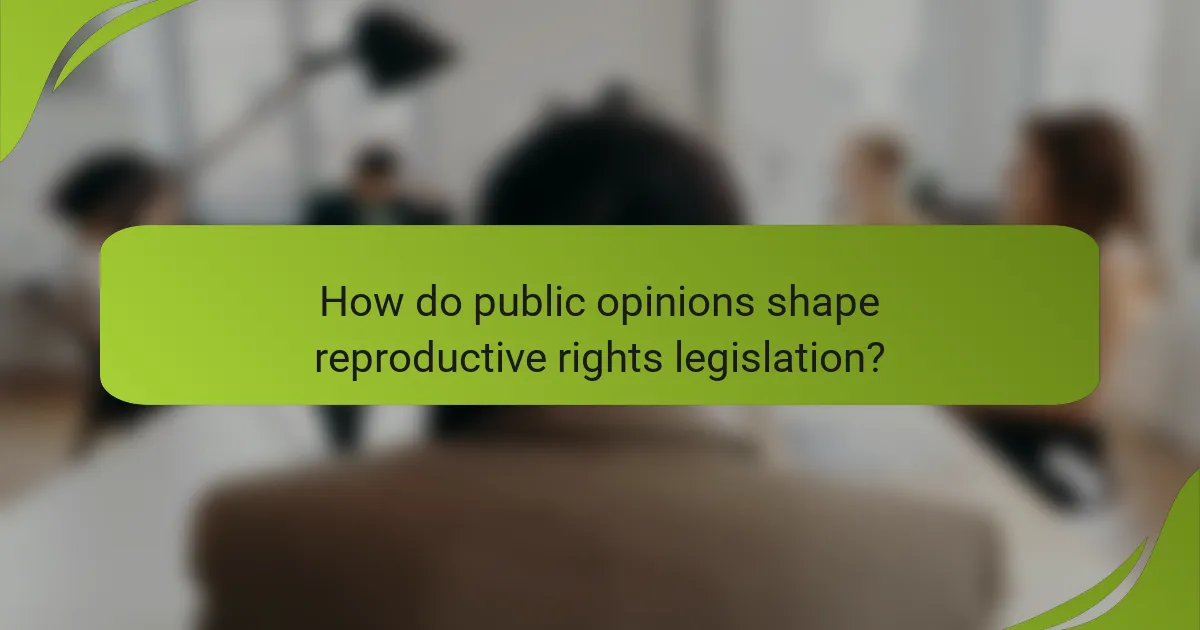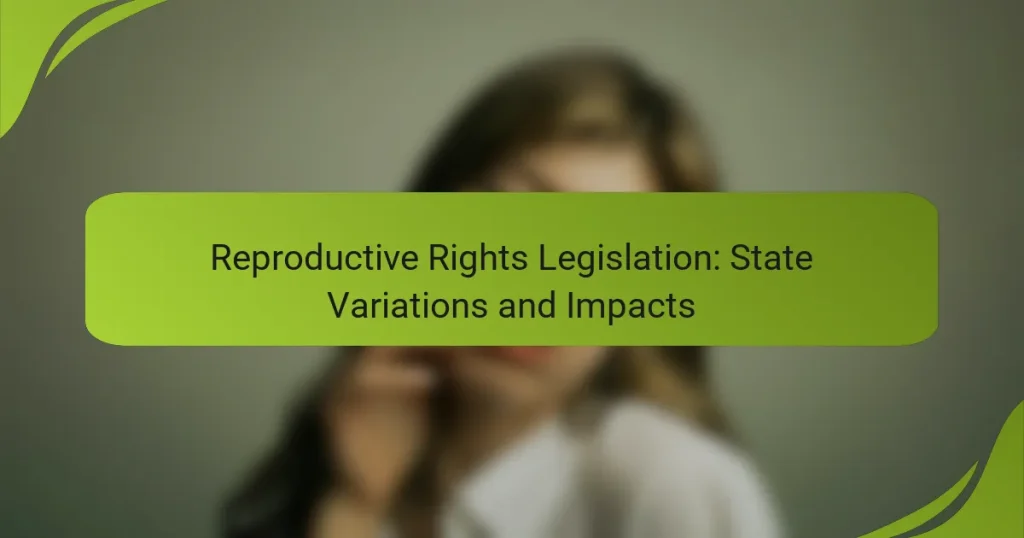Reproductive rights legislation varies significantly across states, shaping access to essential services such as abortion, contraception, and family planning. These legal differences not only influence healthcare availability but also have broader economic implications, affecting state budgets and workforce participation. Understanding these variations is crucial for assessing the overall impact on individuals seeking reproductive health services.

What are the key reproductive rights legislation variations across states?
Reproductive rights legislation varies significantly across states, affecting access to services like abortion, contraception, and family planning. These differences can lead to varying levels of healthcare availability and legal protections for individuals seeking reproductive health services.
State-specific laws overview
Each state has its own set of laws governing reproductive rights, influenced by political, cultural, and social factors. For instance, some states have enacted comprehensive protections for abortion rights, while others have implemented strict regulations that limit access. Understanding these laws is crucial for individuals seeking reproductive health services.
States like California and New York offer robust protections for reproductive rights, including access to abortion and contraception without significant restrictions. In contrast, states such as Texas and Alabama have passed laws that impose waiting periods, mandatory counseling, and gestational limits, which can create barriers to access.
Major differences in access
Access to reproductive health services varies widely, often determined by state legislation. In states with fewer restrictions, individuals may find it easier to obtain services, while those in more restrictive states may face significant hurdles. This includes longer travel distances to clinics, higher costs, and limited availability of healthcare providers.
For example, in states with protective laws, individuals can often access abortion services within days, while in restrictive states, the process may take weeks due to legal requirements and clinic availability. This disparity can lead to increased financial and emotional burdens for those seeking care.
Recent legislative changes
Recent years have seen a wave of legislative changes affecting reproductive rights across the United States. Some states have moved to strengthen protections for reproductive health, while others have enacted laws that further restrict access. These changes often reflect broader political trends and public sentiment regarding reproductive rights.
In 2022, several states introduced or passed laws aimed at protecting abortion rights in response to federal changes, while others implemented more restrictive measures. Keeping abreast of these developments is essential for individuals and advocates to navigate the evolving landscape of reproductive rights effectively.

How do state reproductive rights laws impact access to healthcare?
State reproductive rights laws significantly influence access to healthcare by determining the availability of services related to reproductive health. These laws can create barriers or facilitate access to essential healthcare services, affecting individuals’ ability to receive timely and necessary care.
Healthcare provider restrictions
Many states impose restrictions on healthcare providers, which can limit the types of reproductive health services offered. For example, some states require providers to have specific licenses or adhere to stringent facility standards, which can reduce the number of clinics available to offer services like abortions or contraception.
Additionally, certain states may have laws that allow healthcare providers to refuse services based on personal beliefs, further restricting access. This can lead to significant disparities in care, especially in rural areas where fewer providers are available.
Patient access challenges
Patients often face numerous challenges when trying to access reproductive healthcare, influenced by state laws. Geographic location plays a crucial role; individuals in states with restrictive laws may need to travel long distances to find providers, which can be costly and time-consuming.
Financial barriers also contribute to access issues. In states where insurance coverage for reproductive health services is limited, patients may find themselves facing high out-of-pocket costs, making it difficult to afford necessary care. Understanding local laws and available resources can help patients navigate these challenges more effectively.

What are the economic impacts of reproductive rights legislation?
The economic impacts of reproductive rights legislation can be significant, influencing both state budgets and local economies. These laws can affect healthcare costs, workforce participation, and overall economic productivity.
Cost implications for states
Reproductive rights legislation can lead to varying cost implications for states, often depending on the specific regulations enacted. For instance, states that provide comprehensive reproductive health services may incur higher upfront costs but can save money in the long run through reduced healthcare expenses associated with unintended pregnancies.
Conversely, states that restrict access to reproductive health services may face increased costs related to higher rates of unplanned pregnancies and associated social services. These costs can include increased spending on welfare programs and healthcare for low-income families.
Impact on local economies
The impact of reproductive rights legislation on local economies is multifaceted. Access to reproductive health services can enhance workforce participation, particularly among women, leading to greater economic productivity. When individuals can make informed choices about their reproductive health, they are more likely to pursue education and career opportunities.
On the other hand, restrictive reproductive rights can deter businesses from relocating to or expanding in certain areas, as companies often seek environments that support employee well-being. This can lead to slower economic growth and fewer job opportunities in regions with limited reproductive rights.

How do reproductive rights laws affect social equity?
Reproductive rights laws significantly influence social equity by determining access to healthcare services, including contraception and abortion. Variations in these laws across states can create disparities that disproportionately affect low-income individuals and marginalized communities.
Disparities in access
Access to reproductive health services varies widely depending on state laws, funding, and healthcare infrastructure. Some states have restrictive laws that limit access to abortion clinics and contraceptive services, while others provide comprehensive support. This inconsistency can lead to significant barriers for individuals seeking care, particularly in rural areas where healthcare facilities may be scarce.
For example, states with stringent regulations may require waiting periods, mandatory counseling, or parental consent for minors, which can delay access and create additional hurdles. In contrast, states with more supportive laws often have a higher number of clinics and resources available, making it easier for individuals to obtain necessary services.
Impact on marginalized communities
Marginalized communities often face the greatest challenges in accessing reproductive health services due to systemic inequalities. Low-income individuals, people of color, and those living in rural areas may encounter financial barriers, lack of transportation, or limited availability of culturally competent care. These factors can exacerbate existing health disparities and lead to poorer health outcomes.
Additionally, restrictive reproductive rights laws can disproportionately impact these communities by limiting their autonomy and ability to make informed choices about their reproductive health. For instance, individuals from marginalized backgrounds may be more likely to experience unintended pregnancies or have less access to family planning resources, further entrenching cycles of poverty and inequality.

What are the legal challenges to reproductive rights legislation?
Legal challenges to reproductive rights legislation often arise from conflicts between state laws and federal protections, as well as differing interpretations of constitutional rights. These challenges can take various forms, including lawsuits against restrictive laws, appeals to higher courts, and efforts to overturn established precedents.
Notable court cases
Several landmark court cases have shaped the landscape of reproductive rights in the United States. For instance, Roe v. Wade established the constitutional right to abortion in 1973, while Planned Parenthood v. Casey reaffirmed this right in 1992, allowing states to impose certain restrictions. More recently, cases like Whole Woman’s Health v. Hellerstedt have examined the legality of specific state regulations that could limit access to abortion services.
In 2022, the Supreme Court’s decision in Dobbs v. Jackson Women’s Health Organization overturned Roe v. Wade, leading to significant changes in state laws regarding abortion. This ruling has prompted numerous legal battles across various states as advocates seek to challenge or uphold new restrictions.
Future litigation trends
As reproductive rights continue to evolve, future litigation is likely to focus on state-level restrictions and their implications for access to reproductive healthcare. Legal challenges may increasingly target laws that impose waiting periods, mandatory counseling, or limitations on medication abortions. Advocates will need to monitor these developments closely, as they can vary significantly by state.
Additionally, emerging trends may include the use of state constitutions to protect reproductive rights, as some states have begun to interpret their legal frameworks more expansively. This could lead to a patchwork of protections across the country, with some states enacting stronger safeguards while others impose stricter limitations.

How do public opinions shape reproductive rights legislation?
Public opinion plays a crucial role in shaping reproductive rights legislation, influencing lawmakers’ decisions and the political landscape. As societal views evolve, they can lead to significant changes in laws regarding access to reproductive health services, reflecting the values and priorities of the electorate.
Polling data insights
Polling data provides valuable insights into public attitudes towards reproductive rights, revealing trends and shifts over time. For instance, surveys often show that a majority of Americans support access to contraception and safe abortion services, though opinions can vary significantly by region and demographic factors.
In some states, polling indicates strong support for reproductive rights, while in others, a substantial portion of the population may favor more restrictive measures. Understanding these nuances helps legislators gauge public sentiment and adjust their policies accordingly.
Influence of advocacy groups
Advocacy groups play a pivotal role in shaping public opinion and legislative outcomes related to reproductive rights. Organizations such as Planned Parenthood and the American Civil Liberties Union actively campaign for policies that protect and expand access to reproductive health services, mobilizing grassroots support and raising awareness.
These groups often conduct educational campaigns, provide resources, and engage in lobbying efforts to influence lawmakers. Their ability to frame the narrative around reproductive rights can significantly impact public perception and, in turn, the legislative process.


